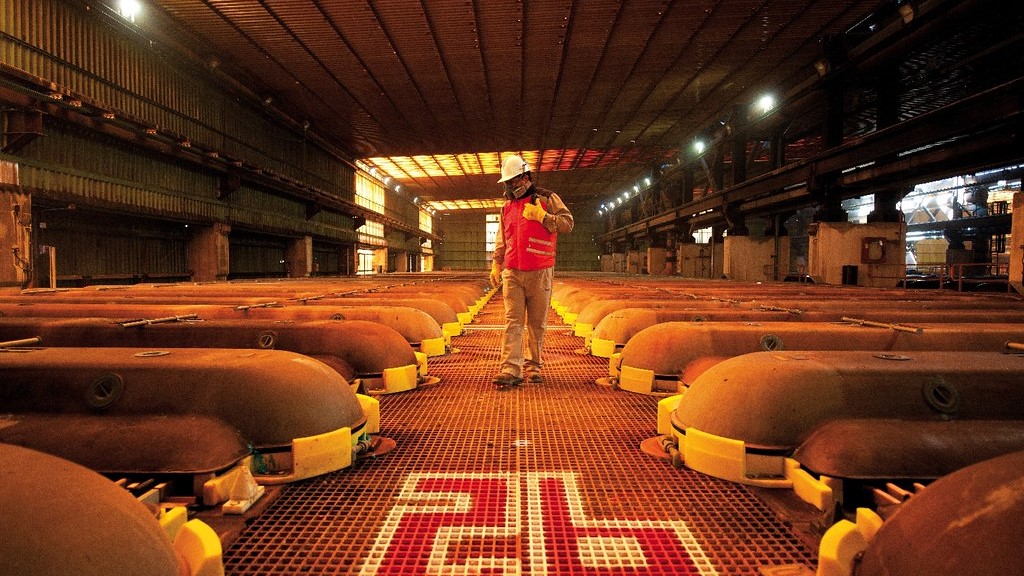Copper – five things to look for in 2019

As we start 2019, the copper market is faced with the prospects of softer demand growth, given the macro economic outlook, constrained mine supply growth, ongoing disruptions at smelters, additional uncertainly around changes to Chinese policies towards copper scrap imports and low visible exchange stocks. All of these factors will no doubt lead to another year of volatile prices. However, in the absence of a major economic downturn, copper’s supportive fundamentals should keep prices skewed to the upside.
Copper prices – underpinned by tight fundamentals in 2019
As anticipated, copper prices were highly volatile during 2018. At the beginning of the year, prices were supported by expectations that the renegotiation of labour contracts would lead to significant supply interruptions. As these labour disruptions failed to materialise, sentiment and prices trended lower.
Prices were supported, albeit briefly in early June, on the back of the closure of the Tuticorin smelter, news that additional environmental checks in China were constraining smelter output and the start of labour negotiations at BHP’s majority-owned Escondida mine.
Despite the tighter supply picture, copper, along with most other commodities, experienced a sizeable sell off as the ‘tit-for-tat’ tariff debacle between China and the USA moved from rhetoric to reality. This dispute and the subsequent deterioration in the global economy shrouded the market in a cloud of uncertainty. The decline in copper prices from their four-year peak in June was exacerbated further as the previously bullish investor community liquidated the long positions that they had built up during 2017.
Although sentiment is likely to remain the overarching influence in the market, cracks in global industrial production may continue to appear and intensify bearish attitudes.
The fundamental outlook for copper in 2019 remains very positive. The market is set to register a sizeable deficit and with stocks drawn down to well below average levels, from a fundamental perspective we expect average annual copper prices to trend higher through the year.
Copper price volatility is likely to be skewed to the upside. However, if 2018 is anything to go by, copper’s fundamentals could yet be overshadowed by events on the global stage. The spectre of a slowing global economy continues to mount, underpinned by the unpredictable trade antics between China and the USA. The ongoing uncertainty around Brexit will add to the volatility, as will the growing concerns over the health of some of Europe’s economies. This uncertainty is keeping investors on the side lines for now, despite the fundamentally robust outlook for copper this year and we would expect prices to take their cues from the associated macro economic and financial news flows.
The withdrawal of Investor interest was a key driver of lower prices through H2 2018 and we believe that interest will remain muted this year given the risk-off attitude that appears to be overhanging global base metal markets at present. The ‘risk-off’ approach to commodities markets adopted by many investors currently is likely to persist until there is further clarity on the trade issues and the macro outlook for a number of the key economies. If the anticipated metal deficits are forthcoming, this could result in significant upside support for copper prices.
The US dollar’s performance played a significant role in commodity price direction throughout 2018 and is likely to do so again this year. The US dollar should continue to weaken as the US Federal Reserve holds off on rate increases. Not only will this support commodity prices, including copper, but it will also be good for emerging markets.
Copper’s fortunes will continue to be influenced heavily by developments in the world’s second largest economy, not least due to the tariff issues but also the additional uncertainty around the Chinese government’s decisions to revise its policy on scrap again. Participants will look carefully for Chinese macro news flows and clarity on scrap. In 2018, tightness in scrap was partly attributable to the upward revision to our refined consumption numbers. Despite the potential upside again in 2019, any slowdown in the Chinese economy could cap that country’s requirements.
Meanwhile, disruptions to the supply side, be they mine or smelter stoppages, will provide upside support to prices, given that the copper market is not flush with visible inventories, which are currently at levels last seen back in January 2015.
Global demand headwinds loom on the horizon
Global economic slowdown and fear of an approaching recession
Whispers of economic slowdown and even recessionary forces are beginning to gain traction across a number of economies and regions. Europe’s engine room, Germany, seems to be misfiring following disappointing industrial output and orders results for November 2018. While a bounce-back in auto production and sales is expected following vehicle emission testing changes, strong headwinds are forecast. Worryingly, following a contraction in Q3 2018 GDP, Germany recorded its slowest economic growth since 2013 at 1.5% over 2017. J.P. Morgan’s recent Global Manufacturing PMI report revealed a 27-month low of 51.5 in December with optimism the weakest in the series’ history, suggesting that industrial slowdown may not be limited to just Germany.
In Japan, a planned hike in consumption tax in October 2019 is anticipated to cause increased consumer purchasing in H1, before a tail off in domestic spending later in the year. History tells us that this could likely bring about a period of economic contraction. However, following a previous hike in consumer tax in April 2014, the Yen depreciated against the US Dollar leading to an increase in exports of semis, wire and cable and consumer goods containing copper.
Despite surging in 2018, attention is beginning to focus on a looming inversion of the US Treasury yield curve. Every US recession since the Second World War has been preceded by an inverted yield curve, which is seen as an insight into investor sentiment. The spotlight will be cast over the US economy this year, as it provided stimulus not only for itself but for a number of key trading partners in 2018. Continuation of the US-China trade war will add further uncertainty to international trade and act as a strong headwind to global economic growth. In a worst case scenario, additional US tariffs on imported EU and Japanese autos would certainly exacerbate the situation and fuel pessimistic economic sentiment, negatively impacting on total copper consumption in this sector.
Chinese demand: what else can the government offer to boost economic growth?
Concerns over the health of Chinese economic growth have been elevated in recent months after a significant slowdown in industrial production growth in November, and a decline in the NBS manufacturing PMI in December to 49.4. A slowing in Chinese demand has been factored into our base case view for 2019: total Chinese copper consumption growth will decelerate from 2.0% in 2018 to 1.6% in 2019. The drag on growth will come mainly from sluggish home appliances production as well as the impact from the trade war. At the same time, strong grid investment driven by the government’s stimulus package, as well as improving housing completions driven by positive housing starts since 2016, will offer some support to growth. Among these base case assumptions, trade negotiations between China and the US, and China’s fiscal and monetary stimulus package will be the two points that will need to be closely monitored in Q1.
In addition, we believe the biggest downside risk to our forecast is from the transport sector. Double digit declines in auto production since September are raising concerns around our total copper consumption growth estimates for this sector. Incentive programs for both the auto and home appliance sectors are in discussion according to a recent statement from the government. This may yet offer some support to total copper consumption within both of these sectors.
Tightened scrap import policy to further increase market deficit?
Scrap supply will be one of the biggest uncertainties for the Chinese copper market in 2019. The key driving force continues to be Chinese policy towards copper scrap imports. Category 6 copper scrap will be reclassified as a ‘restricted import good’ as of 1st July this year, which means that importers will need to obtain an import quota from the government. As we go to print, details are still to be confirmed as to whether some category 6 copper scrap components will be exempt, and also how limited import quotas will be during H2 2019. However, the impact on scrap supply in China will be negative regardless of the details.
As we observed in 2018, lower copper scrap supply will mean that demand for refined copper as a share of total consumption in China will be proportionately higher. Refined copper from secondary producers will also be lower than currently estimated in our 2019 base case. As a result, China will need to import more cathode, blister and/or concentrates. However, it remains to be seen if refineries in the rest of world will be able to raise their production given the current issues around Indian and Chilean smelters and refineries. It is more likely that China will need to import more copper concentrate than estimated in our base case given the disruptions outlined above, and more blister if scrap entering Southeast Asia can be processed into blister and then exported to China. We may also see accelerated scrap imports into the country in H1 before the new policy takes effect. However, if the Chinese authorities decide to reduce category 6 imports significantly, we do not believe that all of the additional imports would be sufficient to completely close the gap that could result over the second half of 2019. Under this scenario, the risk to our global cathode balance is that the deficit will widen, assuming there is no significant reduction in global demand.
Mine production will struggle to see growth, assuming 2019 disruptions are higher
Following a near-3% increase in mine production during 2018 to 20.7Mt, we expect this rate to slow in 2019, with growth of only 0.3% after applying a 5% disruption allowance. Supply increases in 2018 were driven by higher contributions from existing base case mines; between them, Grasberg and Escondida produced around 430kt more last year, close to 65% of the global net increase on 2017. Despite the start-up of greenfield projects such as Cobre Panama, Mirador and Carrapateena in 2019, their contribution will be more than offset by lower production from existing mines, and by Grasberg in particular. This Indonesian operation is expected to deliver less than half the amount of copper that it produced in 2018, as it transitions from the end of open pit mining to additional contributions from underground block caving.
With just over 3% of disruptions in 2018 identified to date, this begs the question as to whether there will also be a shortfall in mine disruptions also in 2019? There are only a handful of new greenfield projects to be commissioned this year. Therefore, the scope for industry to miss guidance due to slow ramp-up of output is limited. There are at least 15 labour contract renewals due for negotiation in Chile during 2019, which is significantly less than in 2018. Regardless, last year demonstrated that the frequency of contract renewals is not necessarily a reliable indicator for predicting industrial action.
As we look to 2019, we believe that heightened global political risks could impact on supply.
This year, elections are due in Indonesia (April) and the Philippines (May). Meanwhile, there has been a recent change in government in Mexico, with a new mining code already proposed. The results of the DR Congo election which took place in late December 2018 are currently being contested. Once resolved, President Joseph Kabila will step down after 18 years in office. There are also ongoing concerns over the impact of the new tax policy in Zambia. We have seen curtailments announced recently at First Quantum’s Sentinel and KCM’s Nchanga operations and expect that the Copperbelt will feature frequently in the news this year.
Our expectation is that earlier stage projects will continue to advance through 2019, and that these should be incentivised by higher copper prices. Furthermore, there will be a requirement to progress projects to feasibility, with the near-term pipeline looking increasingly thin. The steady advancement of new supply into our base case over the last couple of years has resulted in relatively few probable projects in the pipeline. Since the beginning of 2017, we can identify nearly 40 projects with a total production capability of over 2.2Mt/a Cu that have been committed to and that have shifted from our probable category and into our base case. Spence, Quellavaco and most recently Quebrada Blanca Phase 2 contribute nearly half of this capability. There are now 25 uncommitted probable projects remaining, totalling 1.5Mt/a of copper, but only five will have the capability to produce over 100kt/a. Furthermore, at least two of these are held in long-running disputes with local communities. This compares to 5.0Mt/a from 60 probable projects in the pipeline ten years ago, prior to the last boom in copper project development.
Concentrate market to tighten, but a recovery in smelter performance is key
Our base case analysis points to a tightening of the concentrate market through 2019, although this is likely to be weighted toward the second half of the year. Commissioning and ramping up of Chinese copper smelters will contribute to more available capacity. Through 2018, two brownfield expansions (Humon and Zhongyuan), and four greenfield projects (Tongling Jinchang relocation, Chinalco Ningde, Lingbao Jincheng and Qinghai Western Mining) were commissioned. However, these projects have yet to achieve full production and are expected to continue ramping up this year. These smelters account for the majority of smelter production growth in China. Additionally, there are more projects to be commissioned, including Chifeng Yunnan Copper, Wuxin, Qiqihar and Nanguo.
Smelter disruptions dominated industry news in 2018. The causes were varied and included slower ramp-ups at smelters in China due to a combination of tighter emissions and technological issues, ongoing repairs at Pasar, the outage at Tuticorin smelter and late in 2018, various unscheduled shutdowns at Aurubis’ Hamburg, Luenen and Pirdop plants and problems at Gresik in Indonesia.
There are concerns that smelters may continue to falter through the first months of 2019. While there are risks that the issues at Pasar, Aurubis and Gresik are not resolved, there are also uncertainties in Chile regarding new air quality laws, introduced on 12th December, 2018. All Chilean copper smelters now have to comply with the latest environmental regulation (“Decreto Supremo 28”). Codelco’s Chuquicamata and Potrerillos now look set to be under extended maintenance in 2019. We understand the downtime at Potrerillos could be anywhere up to 6 months.
Meanwhile, in India, the outcome of events at Tuticorin will also be a factor. Our base case currently assumes the smelter will remain closed during 2019. However, recent news suggests the National Green Tribunal (NGT) and subsequently, the Supreme Court, have reached a conclusion in favour of Vedanta Resources and a potential restart. However, even under a smooth restart scenario, we believe it is unlikely that this would impact the market until Q2 2019 at the earliest.
Elsewhere the introduction of a 5% duty on concentrates imported into Zambia could materially reduce copper production, particularly at KCM’s Nchanga smelter and NFC’s Chambishi operation, both of whom rely on concentrates from the DRC to bolster blister/anode production.
In addition, various maintenance outages are scheduled during the first half of 2019, particularly in China. Five flash smelters will have major maintenance of anywhere between 30 and 50 days. All of these factors may support spot TCRCs above Benchmark levels (now established at $80.8/t & 8.08c/lb) through the first quarter of the year.
More News
Chile to cut 2025 copper price forecast, WSJ reports
The Chilean government will cut the estimated average price to $3.90 to $4 a pound from a current projection of $4.25.
April 06, 2025 | 10:49 am
Breakthrough Cu-Ta-Li alloy could transform aerospace, defense applications, researchers say
US Army Research Laboratory developed nanostructured copper alloy with exceptional thermal stability and mechanical strength.
April 04, 2025 | 04:17 pm
{{ commodity.name }}
{{ post.title }}
{{ post.excerpt }}
{{ post.date }}



Comments